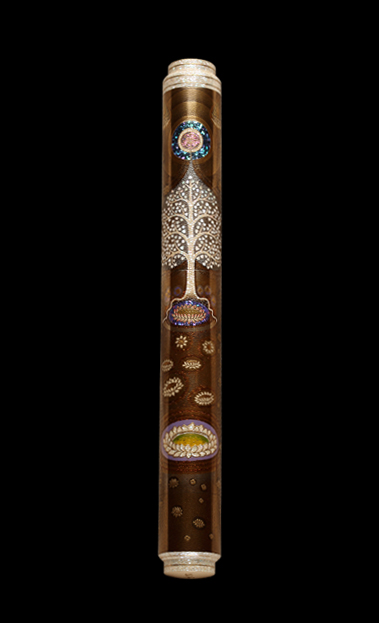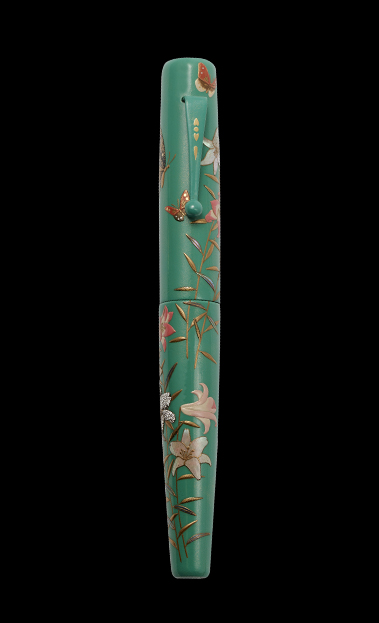Maki-e Lacquer Art
Japanese Maki-e Art dates back 1400 years and is a highly respected and rare form of art. There are but a few living Masters of this art form who continue to keep this tradition alive. A skilled Maki-e Shi (artist) has begun his learning at an early age and works as an apprentice to his master for many years before he may set out on his own.
Maki-e Art features Urushi lacquer (sap from the Urushi tree native to Japan), along with gold powder and other precious metals and powders painted and inlaid into the most exquisite designs that require great skill and precision. The many levels of Maki-e techniques found on our pens include Hira Maki-e, Togidashi Maki-e, Taka Maki-e, Shishiai Togidashi Maki-e and Bokashi Maki-e.
At AP Limited Editions we pride ourselves for having created some of the most exquisite Works in Maki-e ever found on writing instruments. Our Limited Edition Maki-e Fountain Pens are offered with 18K Gold Nibs in various grades.
The Connoisseur
The Connoisseur features our most exclusive and exquisite range of pens that showcase the highest level of artistry achievable in Maki-e. The pens in The Connoisseur are larger in size and are offered in eye dropper or our proprietary bulk filler piston filling mechanism. The edition size is always limited to 9 pens in each theme. The pens are equipped with large 18K Gold nibs available in Fine, Medium and Broad nib widths. These pens are authored by the most honored and revered artists of Japanese Maki-e Art. They are true heirlooms worthy of being handed down from generation to generation.
The Writer
The Writer is an exemplary work of art in a smaller sized pen. These pens are equipped with twist converters or our proprietary bulk piston filling mechanism. The pens are painstakingly handcrafted by renowned artists and masters of Japanese Maki-e. The pens are available with 18K Gold nibs of a smaller size in various widths to include Super Extra Fine, Extra Fine, Fine, Medium and Broad. Some of our Writers come with clips while others are without clips. We also offer Roller Ball pens in this range. We offer a nib customization service to our collectors.
Japanese Maki-e Lacquer Art: An Exploration of Elegance and Endurance
Introduction to Maki-e: The Art of Sprinkled Beauty
In the world of traditional Japanese art, few forms capture the spirit of elegance and meticulous craftsmanship quite like maki-e. This ancient art form, whose name translates to "sprinkled picture," involves delicately applying powdered gold, silver, and sometimes colored pigments onto wet lacquer to create intricate, shimmering designs. Maki-e has adorned everything from ceremonial boxes to fine furniture for centuries, serving not only as decoration but as a bridge between aesthetic philosophy, natural themes, and cultural heritage.
The origins of maki-e trace back to Japan’s Heian period (794–1185), a time when native aesthetics began to mature and diverge from early Chinese influences. While lacquer had long been used for its protective qualities, Japanese artisans transformed it into a highly refined decorative medium, using precious metals and delicate techniques to produce exquisite, enduring designs. Over time, maki-e evolved through different historical periods, incorporating innovations from each era, and eventually blossoming into a hallmark of Japanese art and identity. Today, maki-e remains both a cherished tradition and a testament to the patience, skill, and creative ingenuity of Japanese artisans.
The Beginnings and Evolution of Japanese Lacquer Art
Lacquer art has a deep-rooted history in Japan, with artifacts from as early as the Jomon period (approximately 5,000 BCE) showing traces of lacquered decoration. In these early days, lacquer was primarily used to protect wooden objects from wear, water, and insects. As techniques advanced, however, lacquer evolved beyond its utilitarian role, giving rise to sophisticated, decorative applications.
By the Heian period, Japanese artisans had begun experimenting with adding decorative patterns to lacquered surfaces, developing the first iterations of maki-e. With support from the aristocracy, lacquer art became an important cultural symbol, and decorative lacquer objects were highly sought after. By sprinkling metal powders onto lacquered surfaces, artisans were able to create patterns and images that sparkled with a brilliance unattainable by other means. These early maki-e works would lay the groundwork for later refinements in technique and design.
The Kamakura and Muromachi periods saw lacquer techniques grow increasingly complex, with artists developing unique methods of layering and polishing to enhance visual depth. However, it was during the Edo period (1603–1868) that maki-e truly flourished. In this time of peace and economic stability, both feudal lords and samurai families sought beautifully crafted lacquerware to display their status and taste. This demand spurred artisans to refine maki-e techniques, resulting in the intricate, multi-dimensional designs for which the art form is now celebrated.
Tools and Materials: The Foundation of Maki-e
At the heart of maki-e is urushi lacquer, a unique substance derived from the sap of the lacquer tree (Rhus verniciflua), native to East Asia. This lacquer hardens when exposed to humidity, forming a durable, glossy finish ideal for decoration. Collecting and processing urushi is a delicate process that requires careful handling, as the raw sap is toxic until it has cured. Once refined, however, it becomes a versatile medium that can be polished to a stunning shine or built up in layers to add texture and depth.
The primary tools of maki-e include fine-tipped brushes made from animal hair, small bamboo tubes for sprinkling powder, and specialized spatulas for shaping and smoothing. The gold, silver, and platinum powders used in maki-e are finely ground, often to the consistency of dust, allowing them to adhere to the lacquer in intricate patterns. Other materials, such as abalone shell or colored minerals, may be incorporated to add additional color and luminescence.
The preparation of materials and tools is an art in itself, with each element carefully chosen and prepared. The quality of the urushi, the precision of the brush strokes, and the fineness of the metal powder all contribute to the final piece’s beauty and durability.
Maki-e Techniques: Styles and Innovations
The techniques of maki-e are as varied as they are exquisite, each requiring a specific approach and skill set to master. The main techniques include:
-
Hira Maki-e (Flat Maki-e): The simplest of maki-e techniques, hira maki-e involves applying metal powder directly to wet lacquer to create a flat, uniform design. This technique often serves as a foundational layer in more complex works, adding a gentle shimmer to the piece.
-
Takamaki-e (Raised Maki-e): As the name implies, takamaki-e involves building up layers of lacquer to form a raised, three-dimensional surface. Artisans then apply metal powders to enhance the contours and depth, creating a tactile, sculptural quality. Takamaki-e is a demanding technique, requiring precise layering and polishing to achieve the desired effect.
-
Togidashi Maki-e (Polished Maki-e): One of the most intricate techniques, togidashi maki-e involves covering the metal powder designs with multiple layers of clear or colored lacquer. Once dry, the top layers are carefully polished down to reveal the pattern beneath, producing a smooth, high-gloss finish that highlights the designs with remarkable clarity.
-
Shishiai Maki-e (Sunken Maki-e): This technique involves embedding powdered metal within the lacquer itself, resulting in designs that appear slightly recessed. Combining elements of both flat and raised maki-e, shishiai offers a subtle, textured effect that adds depth and richness to the piece.
These techniques often include additional decorative methods, such as raden (inlaying with iridescent shell fragments) or kirikane (applying tiny gold or silver leaf pieces), to create layers of color and sparkle.
The Aesthetic Philosophy of Maki-e
At the heart of maki-e lies a philosophical approach to beauty, one that aligns with the Japanese aesthetics of wabi-sabi (appreciation of imperfection and transience) and mono no aware (sensitivity to the ephemeral). The delicate, natural motifs that characterize maki-e—branches, blossoms, waves, and clouds—are expressions of this philosophy, capturing fleeting moments in nature and the quiet beauty of the imperfect.
Maki-e artists work not only to create a visual effect but also to imbue each piece with a sense of harmony and reflection. The slow, intentional process, from layering lacquer to polishing each detail, reflects the importance of patience and respect for nature's rhythms. Each brushstroke and sprinkle of powder embodies the artisan's mindfulness, inviting viewers to pause and appreciate the beauty in each detail.
Cultural Importance of Maki-e
Maki-e has been a symbol of status, artistry, and cultural identity throughout Japanese history. Initially, lacquered objects adorned with maki-e motifs were popular among the Heian aristocracy, who favored the art form for its subtlety and elegance. Writing boxes (suzuribako), document cases, and incense containers were common items decorated with maki-e, often featuring poetic and seasonal motifs that reflected the refined tastes of the court.
With the rise of the samurai class during the Edo period, maki-e designs extended to armor, weapons, and personal items, symbolizing the power and prestige of the warrior class. Lacquered helmets, sword sheaths, and even household items were embellished with maki-e designs that represented clan symbols or nature themes, adding a touch of sophistication to everyday objects.
The Meiji period (1868–1912) brought a significant shift as Japan opened to the West, and foreign collectors began to appreciate the artistry of maki-e. Japanese lacquer artisans adapted their designs to suit Western tastes, creating decorative plates, jewelry boxes, and other export items that showcased traditional techniques in new forms. This period of cross-cultural exchange led to increased innovation within maki-e, blending Western artistic influences with traditional Japanese styles.
Today, maki-e continues to hold an important place in Japanese culture, albeit practiced by a smaller community of dedicated artisans. Contemporary artists are adapting maki-e to new mediums and objects, creating works that honor tradition while embracing modern aesthetics. From luxury pens and watches to unique jewelry, maki-e is now applied to various items, keeping the craft alive in both Japan and abroad.
The Future of Maki-e: Challenges and Preservation
Today, the future of maki-e faces significant challenges. The high cost of materials, coupled with a decline in the number of lacquer artisans, threatens the art form’s continuation. Lacquer trees require years to mature and yield only a small amount of usable sap, making lacquer an expensive and limited resource. Additionally, the prices of precious metals such as gold and silver, integral to maki-e, continue to rise.
Nonetheless, efforts are being made to preserve this cherished art form. In Japan, the government designates master artisans as "Living National Treasures," recognizing their role in preserving traditional crafts. Cultural institutions and universities have also established training programs to educate new generations of lacquer artists, ensuring that the techniques and knowledge of maki-e are passed down.
In recent years, contemporary artists have found ways to merge maki-e with modern aesthetics, creating pieces that resonate with today’s audiences. Luxury brands and designers now incorporate maki-e into products such as pens, watches, and jewelry, allowing the art to reach a global audience. Through these adaptations, maki-e remains a relevant and beloved art form, continuing to captivate people with its timeless beauty.
Japanese maki-e is a unique testament to the enduring beauty of traditional craftsmanship, capturing both the meticulous detail and poetic essence of Japanese culture. From its origins as a utilitarian lacquer coating to its rise as a symbol of refinement and artistic mastery, maki-e has evolved alongside Japan’s cultural history. Its blend of artistry and philosophy invites viewers to appreciate nature, imperfection, and the passing of time.
Though challenges remain, the dedication of artisans and the interest of new generations promise to sustain maki-e into the future. As maki-e continues to adapt to contemporary tastes, it preserves its role as a cultural treasure, a reflection of Japanese values, and a timeless expression of beauty in simplicity.


